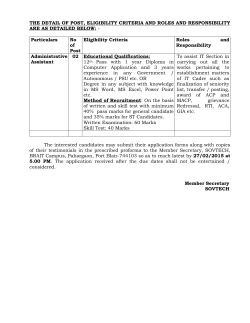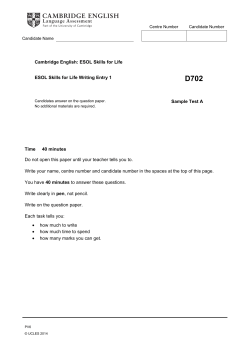
GCE Physics A PHYA2 Mark Scheme June 2011
Version 1.0
General Certificate of Education (A-level)
June 2011
Physics A
PHYA2
(Specification 2450)
Unit 2: Mechanics, materials and waves
Final
Mark Scheme
Mark schemes are prepared by the Principal Examiner and considered, together with the relevant
questions, by a panel of subject teachers. This mark scheme includes any amendments made at the
standardisation events which all examiners participate in and is the scheme which was used by them
in this examination. The standardisation process ensures that the mark scheme covers the
candidates’ responses to questions and that every examiner understands and applies it in the same
correct way. As preparation for standardisation each examiner analyses a number of candidates’
scripts: alternative answers not already covered by the mark scheme are discussed and legislated for.
If, after the standardisation process, examiners encounter unusual answers which have not been
raised they are required to refer these to the Principal Examiner.
It must be stressed that a mark scheme is a working document, in many cases further developed and
expanded on the basis of candidates’ reactions to a particular paper. Assumptions about future mark
schemes on the basis of one year’s document should be avoided; whilst the guiding principles of
assessment remain constant, details will change, depending on the content of a particular examination
paper.
Further copies of this Mark Scheme are available from: aqa.org.uk
Copyright © 2011 AQA and its licensors. All rights reserved.
Copyright
AQA retains the copyright on all its publications. However, registered centres for AQA are permitted to copy material from this
booklet for their own internal use, with the following important exception: AQA cannot give permission to centres to photocopy
any material that is acknowledged to a third party even for internal use within the centre.
Set and published by the Assessment and Qualifications Alliance.
The Assessment and Qualifications Alliance (AQA) is a company limited by guarantee registered in England and Wales (company number 3644723) and a registered
charity (registered charity number 1073334).
Registered address: AQA, Devas Street, Manchester M15 6EX.
Mark Scheme – General Certificate of Education (A-level) Physics A – PHYA2 – June 2011
Instructions to Examiners
1
Give due credit for alternative treatments which are correct. Give marks for what is correct in
accordance with the mark scheme; do not deduct marks because the attempt falls short of
some ideal answer. Where marks are to be deducted for particular errors, specific instructions
are given in the marking scheme.
2
Do not deduct marks for poor written communication. Refer the scripts to the Awards meeting
if poor presentation forbids a proper assessment. In each paper, candidates are assessed on
their quality of written communication (QWC) in designated questions (or part-questions) that
require explanations or descriptions. The criteria for the award of marks on each such
question are set out in the mark scheme in three bands in the following format. The descriptor
for each band sets out the expected level of the quality of written communication of physics for
each band. Such quality covers the scope (eg relevance, correctness), sequence and
presentation of the answer. Amplification of the level of physics expected in a good answer is
set out in the last row of the table. To arrive at the mark for a candidate, their work should first
be assessed holistically (ie in terms of scope, sequence and presentation) to determine which
band is appropriate then in terms of the degree to which the candidate’s work meets the
expected level for the band.
QWC
descriptor
mark range
Good - Excellent
see specific mark scheme
5-6
Modest - Adequate
see specific mark scheme
3-4
Poor - Limited
see specific mark scheme
1-2
The description and/or explanation expected in a good answer should include a
coherent account of the following points:
see specific mark scheme
Answers given as bullet points should be considered in the above terms. Such answers
without an ‘overview’ paragraph in the answer would be unlikely to score in the top band.
3
An arithmetical error in an answer will cause the candidate to lose one mark and should be
annotated AE if possible. The candidate’s incorrect value should be carried through all
subsequent calculations for the question and, if there are no subsequent errors, the candidate
can score all remaining marks.
4
The use of significant figures is tested once on each paper in a designated question or partquestion. The numerical answer on the designated question should be given to the same
number of significant figures as there are in the data given in the question or to one more than
this number. All other numerical answers should not be considered in terms of significant
figures.
5
Numerical answers presented in non-standard form are undesirable but should not be
penalised. Arithmetical errors by candidates resulting from use of non-standard form in a
candidate’s working should be penalised as in point 3 above. Incorrect numerical prefixes and
the use of a given diameter in a geometrical formula as the radius should be treated as
arithmetical errors.
6
Knowledge of units is tested on designated questions or parts of questions in each a paper.
On each such question or part-question, unless otherwise stated in the mark scheme, the
mark scheme will show a mark to be awarded for the numerical value of the answer and a
further mark for the correct unit. No penalties are imposed for incorrect or omitted units at
intermediate stages in a calculation or at the final stage of a non-designated ‘unit’ question.
7
All other procedures including recording of marks and dealing with missing parts of answers
will be clarified in the standardising procedures.
3
Mark Scheme – General Certificate of Education (A-level) Physics A – PHYA2 – June 2011
GCE Physics, Specification A, PHYA2, Mechanics, Materials and Waves
Question 1
a
i
a
ii
gradient (allow ‘slope’/’steepness of the line’) !
1
velocity
0
time
3
single straight line sloping down from X to t2 !
passes through zero at t1 !
increases to a maximum negative value at t2 (ignore all lines beyond t2)
or allow line from zero at t1 to a positive velocity at t2 greater than the initial
velocity !
b
i
ball exerts force on ground and ground exerts force (on ball)/reaction !
and these forces are equal and opposite !
(b)
ii
recognise that the downward force is the weight of the ball (accept
gravity) !
recognition that the upward/reaction force (on the ball) is greater than the
downward force on the ball !
Total
2
2
8
Question 2
a
correct substitution in (v2 = u2 + 2as)
or correct rearrangement g =
!"
#$
or
%.&'"
# ('.)'
!
2
= 9.6 (9.61 m s–1) !
b
c
g = W/m or W = mg (= ma) and weight is proportional to mass/doubling the
mass doubles the weight/’masses cancel’/the factor of two cancels (so g
remains the same) !
1
ball’s acceleration will decrease/be less than cards or cards acceleration will
be unaffected/nearly constant !
air resistance affects cards less or card is more streamlined or card does
less work against air resistance !
alternative timing/(velocity/speed/acceleration) uncertain/(inaccurate
/imprecise/less reliable) !
2
indication that full width of ball may not pass through gate/difficulty in
determining ‘length’ of ball passing through gate !
Total
4
5
Mark Scheme – General Certificate of Education (A-level) Physics A – PHYA2 – June 2011
Question 3
a
a
i
ii
*+ ,
!-.
/
0,
)1
%.)
! = 17 (m s–2) !
2
(F = ma) = 5800 × 16.57 ecf (a)(i) !
= 96000 !
3
allow 98600 or 99000 for use of 17
N!
a
iii
*2 ,
&
#
&
34 5 6780 , × 58 × 3.5 ! = 100 (101.50, 102, accept 101 m) !
#
2
2
2
or use of v = u + 2as (= 101 m. 98.9 for use of 17)
or s = ut +
a
iv
&
#
at2 (= 101.7, use of 17 gives 104) (ecf from (a)(i))
(W = Fs) (a)(ii) × (a)(iii) or use of
*9 ,
:$
/
0,
or use of P =
&
b
#
;<&'< (&'&.)
%.)
:!
#
&
#
mv2 ! (= 13.6 to 14.7 )
3
! = 2.8 M (W) ecf (a)(ii), (a)(iii)
their answer × 5 ! = 14,000,000 = 14 M (W)
(m) v2 = (m) g (Δ) h or (loss of) KE = (gain in) PE !
allow their work done from (iv) used as KE
h=
& !"
# =
&
)1"
#
;.1&
or h = (
3
! accept use of kinematics equation
= 170 !
Total
13
Question 4
a
i
(one) force × distance between the forces !
(one) force × perpendicular distance between the lines of action
or (one) force × perpendicular distance between the (two) forces !
a
ii
(810 × 7.3 =) 5900 ! (5913) (or alternative correct method)
Nm !
b
2
2
P = Fv = (2 ×) 810 × 0.91 !
(1620 × 0.91) = 1500 ! (1474 W)
3
any number to 2 sf !
5
Mark Scheme – General Certificate of Education (A-level) Physics A – PHYA2 – June 2011
c
to enable comparison between steam and horses
or mill owners/engineers etc needed to know which steam engine would be
suitable
or would easily be able to compare the cost/time saved
1
or good marketing ploy for steam engines
or easily understood (by industrialists or the public)
or other suitable valid reason !
Total
8
Question 5
a
decrease !
constant !
3
decrease !
b
A
2
straight ray (ignore arrow) reflecting to the right !
reflected angle = incident angle !
(accept correct angle labels if reflected angle is outside tolerance)
c
i
(n =
>
>?
) use of 3 (× 108) ! =
%'' 3( &'@ 7
#.'A 3( &'@ 7
= 1.47 ! (1.4706) (must see 3 sf or
more)
c
ii
sin θc =
&.A)
&.AB3'<7
or correct substitution in un-rearranged formula !
2
2
θc = 80.4 ! (80.401) (80.3 to 80.54) (≈ 80°) must see 3 sf or more
d
angle of refraction = 180 – 90 – 80.4 = 9.6° !
sinθ = 147(06) sin 9.6 ! = 0.25 ecf from first mark
3
θ = 14 (= 14.194°) ! ecf from first mark
range 13 to 15° due to use of rounded values
e
(reduced amplitude) due to absorption/energy loss (within the fibre)/
attenuation/scattering (by the medium)/loss from fibre !
(pulse broadening caused by) multi-path (modal) dispersion/different rays/
modes propagating at different angles/non axial rays take longer time to
travel same distance along fibre as axial rays !
Total
6
2
14
Mark Sch
heme – Gene
eral Certifica
ate of Educattion (A-level) Physics A – PHYA2 – Ju
une 2011
Questtion 6
a
3
suittable scale on
o both axes (eg not going up in 3s) and
a > ½ spacce used !
≥ 8 points corre
ect (within half a small squ
uare) !
line
e is straight up
u to at least stress = 2.5 × 108 and curve
c
is smoo
oth beyond
stra
aight section !
b
und
derstanding that
t
E = grad
dient (= Δy/Δx) ! allow y//x if line passses through
orig
gin
= 1.05 × 1011 (P
Pa) (allow 0.90 to 1.1) ecff from their lin
ne in (a) if an
nswer
outsside this range and usess a y value ≥ 2.0 !
when values used fro
om table;
●
two marks can be
b scored only if candidattes line passes through
them
m
●
one mark only ca
an be scored
d if these points are not o
on their line
7
2
Mark Scheme – General Certificate of Education (A-level) Physics A – PHYA2 – June 2011
c
correct rearrangement of symbols or numbers ignoring incorrect powers of
ten, eg A =
:C
D∆C
!
correct substitution in any correct form of the equation,
eg =
&'3'''7(%.'
&.;' 3( &'FF 7(&.' 3( &'GH 7
3
! allow incorrect powers of ten for this mark
= 1.6 × 10–4 ! (1.5789) (m2)
Total
8
Question 7
a
The candidate’s writing should be legible and the spelling, punctuation
and grammar should be sufficiently accurate for the meaning to be
clear.
The candidate’s answer will be assessed holistically. The answer will be
assigned to one of three levels according to the following criteria.
High Level (Good to excellent): 5 or 6 marks
The information conveyed by the answer is clearly organised, logical and
coherent, using appropriate specialist vocabulary correctly. The form and
style of writing is appropriate to answer the question.
The candidate provides a comprehensive and coherent description which
includes; fringe spacing/separation w and distance D measured with one
I$
to obtain value for λ, measures distance
instrument named, uses λ =
J
between several maxima and includes a valid point about safety.
Intermediate Level (Modest to adequate): 3 or 4 marks
The information conveyed by the answer may be less well organised and
not fully coherent. There is less use of specialist vocabulary, or specialist
vocabulary may be used incorrectly. The form and style of writing is less
appropriate.
The candidate provides an adequate explanation that lacks some of the
essential points. The candidate is expected to include; w or ‘fringes’
I$
to obtain value for λ. They include one accuracy
measured or uses λ =
J
point or a valid point about safety.
Low Level (Poor to limited): 1 or 2 marks
The information conveyed by the answer is poorly organised and may not
be relevant or coherent. There is little correct use of specialist vocabulary.
The form and style of writing may be only partly appropriate.
The candidate provides a limited explanation with no more than one or two
valid points.
Incorrect, inappropriate of no response: 0 marks
No answer or answer refers to unrelated, incorrect or inappropriate physics.
8
max 6
Mark Scheme – General Certificate of Education (A-level) Physics A – PHYA2 – June 2011
The explanation expected in a competent answer should include a
coherent selection of the following points.
Measurements
•
suitable measuring instrument for w
•
suitable measuring instrument for D
Finding the wavelength
I$
•
uses λ =
•
explains graphical approach
J
to obtain value for λ
Accuracy
•
several fringe spaces measured
•
centres of fringes used
•
five or more fringes/four fringe spaces measured
•
large value of D
•
D greater than or equal to 2 m
•
dark room
•
repeat measurements
•
vernier calliper for w (not ‘calliper’, not micrometer)
•
graphical method varying D and measuring w
•
other valid accuracy point
Safety
b
•
avoid shining laser at (or near) a person
•
laser safety goggles
•
avoid reflections
•
warning sign or light
(light from both sources has) constant phase relationship/difference !!
‘in phase’ or ‘same wavelength’ or ‘same frequency’ is one mark
c
single slit then double slits to the right !
single slit and double slits labelled !
9
2
2
Mark Scheme – General Certificate of Education (A-level) Physics A – PHYA2 – June 2011
d
if candidate refers to white light
Young’s fringes with white light;
or
if candidate refers to the laser;
contain (different) colours or
central white fringe
monochromatic/one colour
less intense
more intense
maxima wider/minima narrower
or max or min closer together for
white light compared to a red
laser
maxima narrower/minima wider
or max or min further apart for a
red laser
fringes/lines/bands etc compared
to ‘dots’
‘dots’ for laser compared to
‘bands’ etc
2
from each row, one only max 2 !
e
cancellation/waves cancel/destructive interference/destructive
superposition !
2
(light from one slit meets light from the other) in antiphase (180 out of
phase) or a path difference of ((n+) ½)λ !
Total
UMS conversion calculator www.aqa.org.uk/umsconversion
10
14
© Copyright 2025











